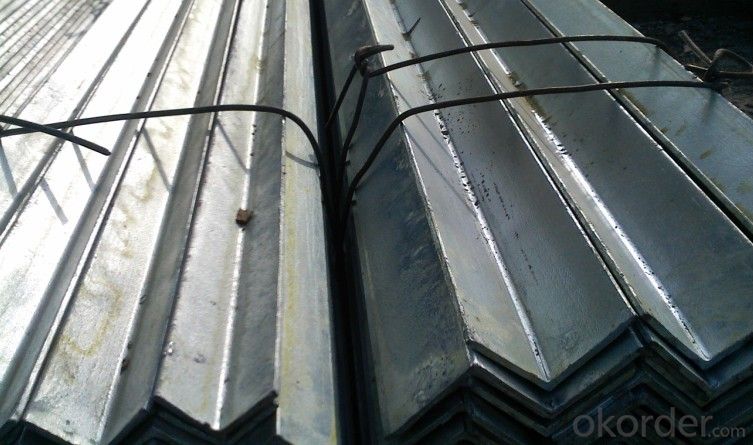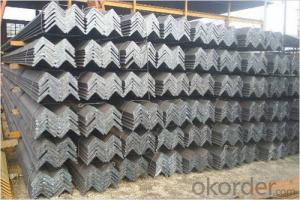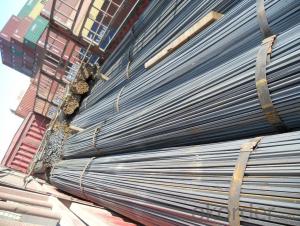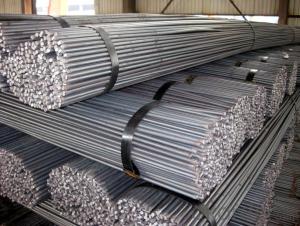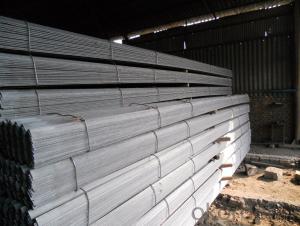Hot Rolled Equal Angle Bar Q235,SS400,A36,S235JR
- Loading Port:
- Tianjin
- Payment Terms:
- TT or LC
- Min Order Qty:
- 25 m.t.
- Supply Capability:
- 200000 m.t./month
OKorder Service Pledge
OKorder Financial Service
You Might Also Like
Product Description:
OKorder is offering Hot Rolled Equal Angle Bar Q235,SS400,A36,S235JR at great prices with worldwide shipping. Our supplier is a world-class manufacturer of steel, with our products utilized the world over. OKorder annually supplies products to African, South American and Asian markets. We provide quotations within 24 hours of receiving an inquiry and guarantee competitive prices.
Product Applications:
Hot Rolled Equal Angle Bar Q235,SS400,A36,S235JR are ideal for structural applications and are widely used in the construction of buildings and bridges, and the manufacturing, petrochemical, and transportation industries.
Product Advantages:
OKorder's Hot Rolled Equal Angle Bar Q235,SS400,A36,S235JR are durable, strong, and wide variety of sizes.
Main Product Features:
· Premium quality
· Prompt delivery & seaworthy packing (30 days after receiving deposit)
· Can be recycled and reused
· Mill test certification
· Professional Service
· Competitive pricing
Product Specifications:
Manufacture: Hot rolled
Grade: Q195 – 235
Certificates: ISO, SGS, BV, CIQ
Length: 6m – 12m, as per customer request
Packaging: Export packing, nude packing, bundled
| EQUAL ANGLE STEEL | |||||
| size(mm) | a(mm) | a1(mm) | thickness(mm) | kg/m | length |
| 50*50*4 | 50 | 50 | 4 | 3.059 | 6m,9m,12m |
| 50*50*5 | 50 | 50 | 5 | 3.77 | 6m,9m,12m |
| 50*50*6 | 50 | 50 | 6 | 4.465 | 6m,9m,12m |
| 63*63*5 | 63 | 63 | 5 | 4.822 | 6m,9m,12m |
| 63*63*6 | 63 | 63 | 6 | 5.721 | 6m,9m,12m |
| 65*65*5 | 65 | 65 | 5 | 5 | 6m,9m,12m |
| 65*65*6 | 65 | 65 | 6 | 5.91 | 6m,9m,12m |
| 65*65*8 | 65 | 65 | 8 | 7.66 | 6m,9m,12m |
| 75*75*5 | 75 | 75 | 5 | 5.818 | 6m,9m,12m |
| 75*75*6 | 75 | 75 | 6 | 6.905 | 6m,9m,12m |
| 75*75*8 | 75 | 75 | 8 | 9.03 | 6m,9m,12m |
| 75*75*9 | 75 | 75 | 9 | 9.96 | 6m,9m,12m |
| 75*75*10 | 75 | 75 | 10 | 11.089 | 6m,9m,12m |
| 80*80*6 | 80 | 80 | 6 | 7.375 | 6m,9m,12m |
| 80*80*7 | 80 | 80 | 7 | 8.525 | 6m,9m,12m |
| 80*80*8 | 80 | 80 | 8 | 9.658 | 6m,9m,12m |
| 80*80*10 | 80 | 80 | 10 | 11.874 | 6m,9m,12m |
| 90*90*6 | 90 | 90 | 6 | 8.35 | 6m,9m,12m |
| 90*90*7 | 90 | 90 | 7 | 9.656 | 6m,9m,12m |
| 90*90*8 | 90 | 90 | 8 | 10.946 | 6m,9m,12m |
| 90*90*10 | 90 | 90 | 10 | 13.476 | 6m,9m,12m |
| 100*100*6 | 100 | 100 | 6 | 9.366 | 6m,9m,12m |
| 100*100*7 | 100 | 100 | 7 | 10.83 | 6m,9m,12m |
| 100*100*8 | 100 | 100 | 8 | 12.276 | 6m,9m,12m |
| 100*100*9 | 100 | 100 | 9 | 13.49 | 6m,9m,12m |
| 100*100*10 | 100 | 100 | 10 | 15.12 | 6m,9m,12m |
| 100*100*12 | 100 | 100 | 12 | 17.898 | 6m,9m,12m |
| 120*120*8 | 120 | 120 | 8 | 14.88 | 6m,9m,12m |
| 120*120*10 | 120 | 120 | 10 | 18.37 | 6m,9m,12m |
| 120*120*12 | 120 | 120 | 12 | 21.66 | 6m,9m,12m |
| 125*125*8 | 125 | 125 | 8 | 15.504 | 6m,9m,12m |
| 125*125*10 | 125 | 125 | 10 | 19.133 | 6m,9m,12m |
| 125*125*12 | 125 | 125 | 12 | 22.696 | 6m,9m,12m |
| 130*130*10 | 130 | 130 | 10 | 19.8 | 6m,9m,12m |
| 130*130*12 | 130 | 130 | 12 | 23.6 | 6m,9m,12m |
| 130*130*13 | 130 | 130 | 13 | 25.4 | 6m,9m,12m |
| 130*130*14 | 130 | 130 | 14 | 27.2 | 6m,9m,12m |
| 150*150*10 | 150 | 150 | 10 | 23 | 6m,9m,12m |
| 150*150*12 | 150 | 150 | 12 | 27.3 | 6m,9m,12m |
| 150*150*14 | 150 | 150 | 14 | 31.6 | 6m,9m,12m |
| 150*150*15 | 150 | 150 | 15 | 33.8 | 6m,9m,12m |
| 140*140*10 | 140 | 140 | 10 | 21.49 | 6m,9m,12m |
| 140*140*12 | 140 | 140 | 12 | 25.52 | 6m,9m,12m |
| 140*140*14 | 140 | 140 | 14 | 29.49 | 6m,9m,12m |
| 160*160*10 | 160 | 160 | 10 | 24.73 | 6m,9m,12m |
| 160*160*12 | 160 | 160 | 12 | 29.39 | 6m,9m,12m |
| 160*160*14 | 160 | 160 | 14 | 33.99 | 6m,9m,12m |
| 180*180*12 | 180 | 180 | 12 | 33.16 | 6m,9m,12m |
| 180*180*14 | 180 | 180 | 14 | 39.39 | 6m,9m,12m |
| 180*180*16 | 180 | 180 | 16 | 43.45 | 6m,9m,12m |
| 180*180*18 | 180 | 180 | 18 | 48.63 | 6m,9m,12m |
| 200*200*14 | 200 | 200 | 14 | 42.89 | 6m,9m,12m |
| 200*200*16 | 200 | 200 | 16 | 48.68 | 6m,9m,12m |
| 200*200*18 | 200 | 200 | 18 | 54.4 | 6m,9m,12m |
| 200*200*20 | 200 | 200 | 20 | 60.06 | 6m,9m,12m |
| 200*200*24 | 200 | 200 | 24 | 71.17 | 6m,9m,12m |
Trademark | Rank | Chemical composition (quality score) % | |||||
C | Si | Mn | S | P | |||
≤ | ≤ | ≤ | |||||
Q235 | A | 0.14-0.22 | 0.30 | 0.30-0.65 | 0.050 | 0.045 | |
Q235 | B | 0.12-0.20 | 0.30 | 0.30-0.70 | 0.045 | 0.045 | |
Trademark | Rank | Pulling Test | |||||
Bend PointΔs/Mpa | Tensile Strength | Elongation Ratioδ5% | |||||
Thickness (Diameter) /MM | Thickness (Diameter) /MM | ||||||
≤16 | 16-40 | ≤16 | 16-40 | ||||
≥ | ≥ | ||||||
Q235 | A | 235 | 225 | 375-500 | 26 | 25 | |
Q235 | B | 235 | 225 | 375-500 | 26 | 25 | |
FAQ:
Q1: Why buy Materials & Equipment from OKorder.com?
A1: All products offered byOKorder.com are carefully selected from China's most reliable manufacturing enterprises. Through its ISO certifications, OKorder.com adheres to the highest standards and a commitment to supply chain safety and customer satisfaction.
Q2: How many tons of steel products could be loaded in containers?
A2: Usually the steel products are delivered by bulk vessel because of the large quantity and the freight. However, there are no bulk vessel enter some seaports so that we have to deliver the cargo by containers. The 6m steel product can be loaded in 20FT container, but the quantity is changed according to the size, usually from 18tons to 25tons.
Q3: How soon can we receive the product after purchase?
A3: Within three days of placing an order, we will arrange production. The normal sizes with the normal grade can be produced within one month. The specific shipping date is dependent upon international and government factors, the delivery to international main port about 45-60days.
Images:

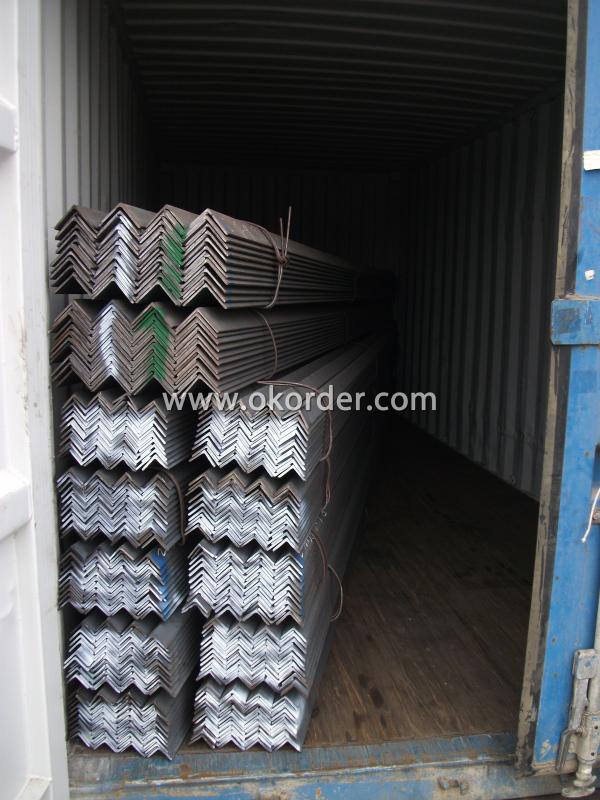
- Q: What are the different methods of fire protection for steel angles?
- There are several methods of fire protection for steel angles, including the use of fire-resistant coatings, intumescent paint, encasement with gypsum boards, and the application of fire-resistant sprays. These methods aim to slow down the heating of steel angles during a fire, allowing more time for evacuation and firefighting efforts.
- Q: What are the different types of steel angles?
- There are several different types of steel angles, each designed for specific applications and purposes. Some of the common types include: 1. Equal angle: This type of steel angle has equal sides and is widely used in construction for structural support, bracing, and framing. 2. Unequal angle: Also known as L-shaped or unequal leg angle, this type of steel angle has unequal sides, with one longer side and one shorter side. It is commonly used in building construction to create corners, edges, and supports. 3. Stainless steel angle: Made from stainless steel, this type of angle offers excellent corrosion resistance and is commonly used in applications where exposure to moisture or chemicals is a concern, such as in marine environments or food processing facilities. 4. Galvanized angle: Galvanized steel angles are coated with a layer of zinc to provide protection against rust and corrosion. They are commonly used in outdoor and industrial applications where durability is essential. 5. Slotted angle: Slotted steel angles have holes or slots along their length, allowing for easy attachment and adjustment of components. They are commonly used in shelving systems, storage racks, and DIY projects. 6. Rolled steel angle: This type of angle is created by rolling steel into a specific shape, resulting in a uniform and smooth surface. Rolled steel angles are often used in manufacturing, machinery, and structural applications. 7. Structural angle: Structural steel angles are designed to bear heavy loads and provide structural support in construction projects. They are often used in building frames, bridges, and other infrastructure projects. These are just a few examples of the different types of steel angles available. The choice of angle will depend on the specific requirements of the project, including load capacity, corrosion resistance, and aesthetic considerations. Consulting with a professional or structural engineer can help determine the most suitable type of steel angle for a particular application.
- Q: Can steel angles be used for manufacturing decorative brackets?
- Yes, steel angles can be used for manufacturing decorative brackets. The angles can be cut and shaped to create various designs, making them suitable for decorative purposes while also providing the necessary strength and durability.
- Q: How do you calculate the compression capacity of a steel angle?
- In order to determine the compression capacity of a steel angle, it is necessary to take into account various factors, such as the properties of the steel angle and the applied load. The following step-by-step guide outlines the process for calculating the compression capacity: 1. Begin by assessing the properties of the steel angle. This involves noting the angle's dimensions, including length, thickness, and width. Additionally, it is crucial to be aware of the material properties of the steel, including the yield strength and modulus of elasticity. 2. Next, ascertain the effective length of the steel angle. This refers to the unsupported length of the angle. Considering the effective length is critical as it impacts the angle's buckling behavior when subjected to compression. 3. Proceed to compute the slenderness ratio, which is the ratio of the effective length to the radius of gyration of the steel angle. The radius of gyration can be determined based on the angle's dimensions. The slenderness ratio aids in determining the angle's buckling capacity. 4. Determine the critical stress, which is the stress at which the steel angle commences buckling under compression. Euler's formula can be utilized to calculate the critical stress. This formula is expressed as follows: Critical stress = (π^2 * modulus of elasticity * moment of inertia) / (effective length)^2 5. Lastly, calculate the compression capacity, which denotes the maximum load that the steel angle can endure before buckling. This can be accomplished by multiplying the critical stress by the cross-sectional area of the angle: Compression capacity = critical stress * cross-sectional area By following these outlined steps, it becomes possible to calculate the compression capacity of a steel angle. Nonetheless, it is important to note that this approach is a simplified one. For more precise and accurate calculations, it is recommended to refer to relevant design codes, standards, or seek the guidance of a structural engineer.
- Q: Can steel angles be used in the construction of railway bridges?
- Yes, steel angles can be used in the construction of railway bridges. Steel angles are versatile structural elements that can be used in various applications, including bridge construction. They are commonly used in the fabrication of bridge girders, braces, and supports. Steel angles provide excellent strength and load-bearing capabilities, making them suitable for railway bridges that require high structural integrity and durability. Additionally, steel angles can be easily welded, bolted, or riveted together, allowing for efficient and cost-effective construction. Overall, steel angles are a viable and commonly used component in the construction of railway bridges.
- Q: How are steel angles protected against impact or collision damage?
- Steel angles can be protected against impact or collision damage through various methods. One common approach is to use protective barriers or bollards strategically placed around the angles to absorb the impact and prevent direct contact. These barriers can be made from materials such as concrete, rubber, or steel, depending on the level of protection required. Another method is to install impact-resistant guards or shields directly on the steel angles. These guards are typically made of materials like polyethylene, rubber, or heavy-duty plastic, which can absorb the impact and minimize damage to the angles. In some cases, additional reinforcement, such as steel plates or bars, can be incorporated into the guards for enhanced protection. Furthermore, steel angles can be coated or painted with impact-resistant coatings or paints. These coatings are designed to absorb and disperse the force of an impact, reducing the likelihood of damage. Additionally, they can provide an extra layer of protection against corrosion, which further safeguards the angles from deterioration due to impact. Lastly, engineering and design considerations can also help protect steel angles against impact damage. By properly evaluating the structural requirements and potential risks, engineers can choose appropriate dimensions, materials, and reinforcement techniques to enhance the angles' resistance to collision damage. This includes considering factors such as load-bearing capacity, impact force distribution, and structural integrity. Overall, the protection of steel angles against impact or collision damage involves a combination of physical barriers, guards, coatings, and thoughtful engineering. These measures aim to minimize the risk of damage, prolong the lifespan of the angles, and ensure their structural integrity in various applications.
- Q: What are the different types of connections used for steel angles in residential applications?
- There are several different types of connections used for steel angles in residential applications. Some of the most commonly used ones include: 1. Welded connections: This is the most common type of connection used for steel angles. It involves welding the angle to the adjacent structural members, such as beams or columns. Welded connections provide excellent strength and rigidity, making them ideal for residential applications. 2. Bolted connections: Bolted connections involve using bolts and nuts to secure the steel angle to the adjacent members. This type of connection is often used when the angle needs to be easily removable or adjustable. Bolted connections are less rigid than welded connections but still provide sufficient strength for residential applications. 3. Clip connections: Clip connections are typically used to connect steel angles to wood or other non-steel materials. They involve using clips or brackets that are attached to the angle and then fastened to the adjacent material using screws or nails. Clip connections are commonly used in residential framing applications. 4. Gusset plate connections: Gusset plate connections are used when two steel angles need to be connected at a joint. A gusset plate, which is a flat plate of steel, is welded or bolted to the angles to provide additional support and rigidity. This type of connection is often used in residential roof trusses and other structural applications. 5. Cleat connections: Cleat connections involve using a steel plate, called a cleat, that is bolted or welded to the steel angle and the adjacent member. Cleat connections are commonly used when the angle needs to be attached to a horizontal member, such as a floor or roof joist. These are just a few examples of the different types of connections used for steel angles in residential applications. The choice of connection type will depend on factors such as the structural requirements, ease of installation, and the type of materials being connected.
- Q: What are the different methods of reinforcing steel angles?
- There are several methods of reinforcing steel angles, each with its own advantages and applications. One common method is the use of additional steel plates or brackets. These plates or brackets are typically welded or bolted to the existing steel angle to provide additional support and strength. This method is often used in applications where the steel angle is subject to high loads or stresses. Another method is the use of stiffeners, which are typically smaller steel angles or plates welded perpendicular to the existing angle. These stiffeners help to distribute the load more evenly and prevent the steel angle from buckling or bending under stress. This method is often used in applications where the steel angle is used as a structural member, such as in building frames or bridge supports. Additionally, reinforcing steel angles can be achieved through the use of concrete encasement or composite materials. In this method, the steel angle is embedded within a concrete matrix or combined with other materials such as fiberglass or carbon fiber. This combination provides enhanced strength, durability, and resistance to corrosion. This method is commonly used in construction projects where the steel angle is exposed to harsh environments or requires high performance. Overall, the different methods of reinforcing steel angles provide options for increasing the strength, stability, and durability of these structural components. The choice of method will depend on the specific application, load requirements, and environmental factors.
- Q: What do you mean by "corner steel plate pull knot"?
- The specifications are expressed in millimeters of edge width * edge width * edge thickness. Such as "30 x 30 x 3", that is 30 mm width equal angle, edge thickness of 3 mm. Also available models that model is the number of centimeters wide, such as 3#. The model does not mean the size of the different edges and sizes of the same model. Therefore, the width, the edge and the thickness of the angle iron should be filled out in the contract and other documents, so as not to be indicated by the model alone. Standard Specification for hot-rolled equal angle iron is 2#-20#.
- Q: What are the different shapes available for steel angles?
- The different shapes available for steel angles include equal angles, unequal angles, and L-shaped angles.
Send your message to us
Hot Rolled Equal Angle Bar Q235,SS400,A36,S235JR
- Loading Port:
- Tianjin
- Payment Terms:
- TT or LC
- Min Order Qty:
- 25 m.t.
- Supply Capability:
- 200000 m.t./month
OKorder Service Pledge
OKorder Financial Service
Similar products
Hot products
Hot Searches
Related keywords





